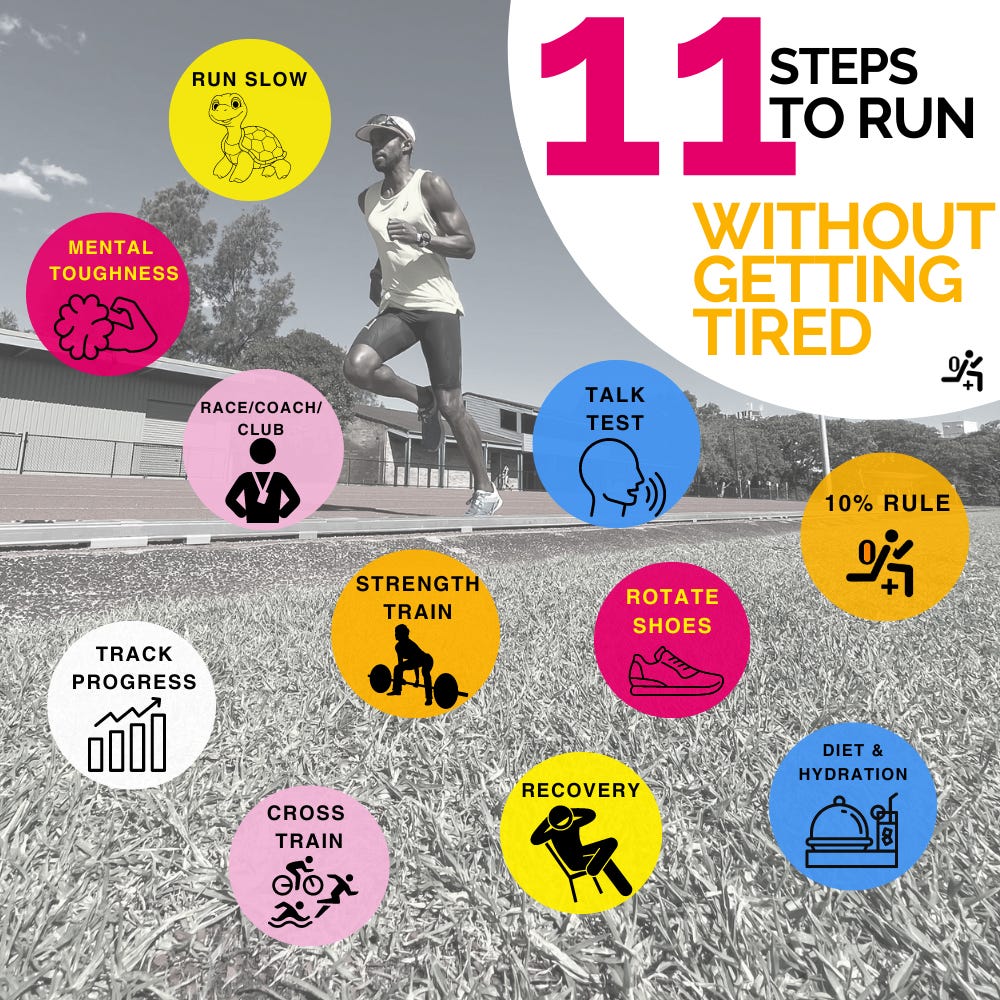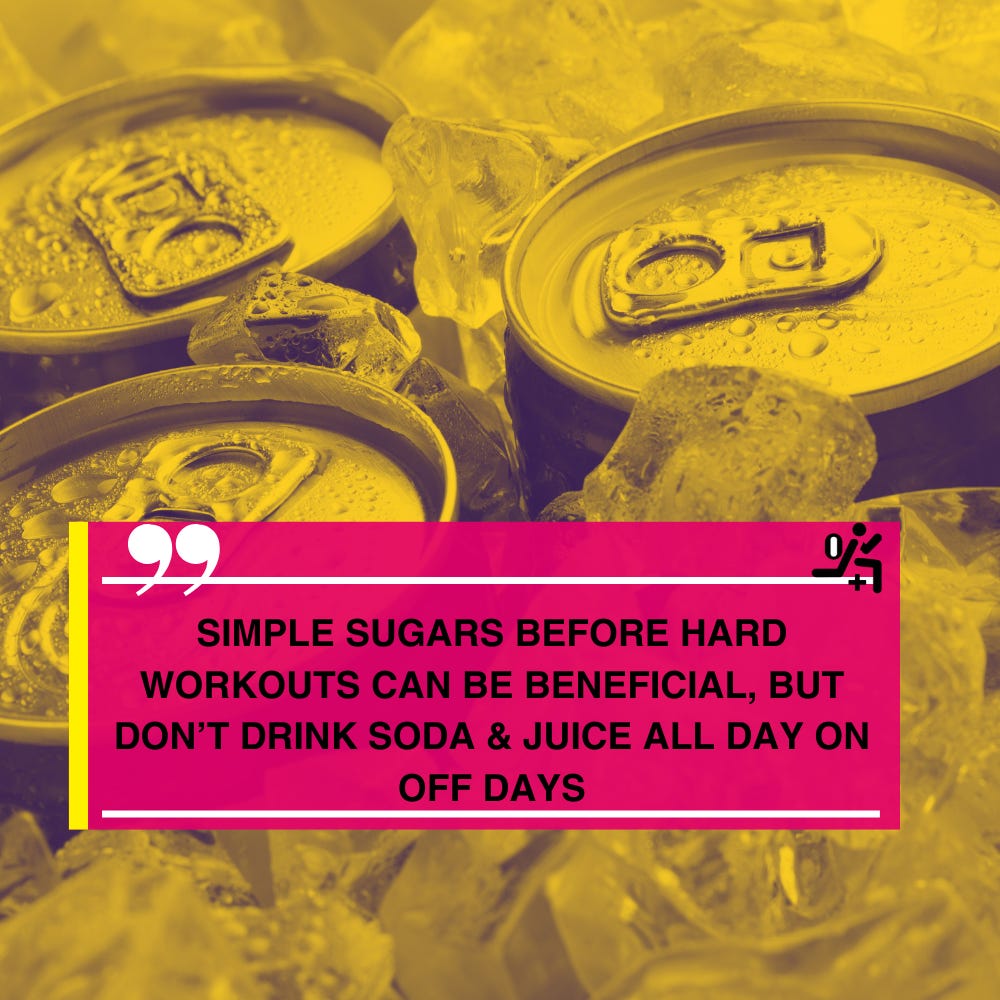11 Ways To Run Longer, Farther and Not Hit The Wall
Workout Of The Month: 90 min long progression aerobic pyramid Run
♾️ How To Run Forever
🏃🏽♂️Workout of the Month: 90 min Long Run Progressive Aerobic Pyramid Run
🐢 Consistency Before Intensity
♾️ 11 Ways To Run Longer & Farther Without Hitting The Wall
Ever wonder how our ancestors chased down prey without Nikes or energy gels?
Simple - They perfected the art of persistence hunting, which wasn’t about speed but stamina.
By jogging slowly, walking, and stopping here and there, they could follow prey for days until the animals simply collapsed from exhaustion. This was possible thanks to their incredible ability to sweat and harness the power of oxygen and fat as fuel.
Now, how do we channel that inner caveman to run forever without bonking and hitting the wall? I’ll answer that and more up next.
What You’ll Learn
I’m going to show you my eleven steps to run ALMOST forever without getting tired. I’ll start with three easy “hack” like technique-related things you can do right now. Then, I’ll progress to eight critical habits you can incorporate into your training life as you build your distance to run farther.
If you follow these eleven steps, you can improve by 1% each day, run without getting tired for as long as possible, and perform better as you age.
Win-Win-Win in my book.
1. Practice Running Slow
Start by running slowly and gradually increase your pace and distance to prevent early fatigue.
This is way easier said than done, and most experienced runners—myself included—mess this up because “it feels good to run fast.”
One hack I’ve found is to use the run-walking technique. This method was developed by former Olympian Jeff Galloway in the 1970s. Even I do it and have run a sub3-hour marathon.
2. Use The Talk Test
If you use a five-zone heart rate system, easy running is usually zones one and two. ** The show notes provide More information about heart rate zones.
How do you know you’re running easy? You are easy if you can complete entire sentences without gasping for air mid-way.
How does this work? When running easy, you are aerobic and mainly use oxygen to fuel your muscles. Simply speaking, the air you breathe in gets used to propel you forward.
Are you into tech and gadgets? Get a chest strap heart rate monitor and pair it with your smartwatch. Find out your zone 1/zone 2 from a few tests and stay there. Yes, it’s that easy. But without going on a rant, you must train your body in many different ways to do this if you want to run for hours on end and complete a marathon.
3. Sign Up For A Race, Rind A Coach Or Join A Club
Find a race or event that excites and scares you. Then, follow a training plan to stay motivated and achieve your goals.
Finding a coach is the next step if you have the capacity and money, but getting a training plan that adapts to your needs and life is just as effective early on.
A run community/club is your last option, and you can combine it with the two. They offer a community and social vibe that can boost your motivation. But remember, these groups may only sometimes match your specific pace or training needs.
Try it all.
Alright - here are eight more key steps that take a bit more work than the previous three, but if you stack them up, they create insurance for you to stay healthy. Which means you can run forever.
These eight things also involve improving your ability to use fat and oxygen as fuel more efficiently. This is how you get 1% better each day, run not just without getting tired but for as long as possible, and perform better as you age. Do most of them on most days, and you’ll bank up enough health credits to get through the inevitable punches life throws at you.
4. Strength Training
Most runners know they should strength train more, but most fail to do it. From my research, it’s a combo of time and mental energy. Not another thing, right? Yes, but if you want to run without getting tired, you need to set aside 20-45 minutes 2-3 times a week to strength train.
Think of it as insurance for your overall body as you get older. Running is great for cardio health, but it doesn’t build strength and breaks down muscle.
How to do it? There are so many plans, websites, and exercises out there that I won’t go into too much detail because ** I’ve already done a few episodes on that here and in the show notes,
My rule is that you should try to lift heavy (almost to failure) whenever possible and with force/power. Kettlebell swings, plyos, box jumps, form drills, and even sprints are simple, low-equipment ways of proper run strength training.
But the best plan is the one you stick with for as long as possible.If you want to step up your game, go to a specialized running physical therapist and have them assess your running form and body. They will get your history, and you will tell them your goals. They can then give you specific workouts.
Shoes/Footwear
In running, everyone thinks shoes are everything. While I don’t buy all the hype around shoes, I know they are essential. It’s the only thing that touches the ground and your body. I won’t go into what shoes are best, but I will just give you some simple guidelines and rules.
Rotate your shoes. If possible, have 2-3 different shoes for different types of runs. Light, fast shoes for fast workouts, races, and longer ones, and more cushioned and structured shoes for shorter, easier runs.
Change shoes out every 400-800km/250 -500 miles. This varies based on the shoe, your run gait, etc. However, higher-end carbon shoes or high-heeled drop shoes with a lot of structure usually wear out faster. Minimal essential shoes and lower heel drop last longer.
6. Diet, Nutrition, Hydration and Electrolytes
What goes in your body is your fuel. Again, most people know this is obvious, but when you start ramping up your running, you get really hungry and eat most things in sight. I’ve found meal planning and knowing what to eat after specific workouts at certain times is best.
Don’t like eating the same thing all the time like me? Add variety to your meals by having 2-3 variations of your staples.
Hydration throughout the day is another “duh”, but don’t overdo it. Drink to thirst and make sure your pee isn’t dark. Salt, magnesium, and a range of electrolytes are just as important as drinking water on hard, long, hot days.
You need a healthy mix of good fats, protein and carbs. Yes, you can get away with running in a low-carb state, but if you want to run very far, science has proven the body runs best on carbs. Simple sugars get a bad wrap but can be beneficial immediately before, during and after a hard workout. Should you be drinking fruit juice or soda all day, though, on a rest day? Probably not the best move. Not sure what’s best? See a sports nutritionist/dietician to dial in your diet.
Read, watch and listen to the other five ways on your next run or workout here.
🏃🏽♂️Workout of the Month: 90 min Long Run Progressive Aerobic Pyramid Run
You can “run with me,” as I went more in-depth on this in a recent video podcast episode about running faster at a lower heart rate. Read, watch, or listen to it on your next run or ride here.
What is it?
A Long Run Progressive Aerobic Pyramid Run is like a workout where you start easy, ramp up the intensity, and then bring it back down, kinda like a pyramid. It's meant to hit different effort levels to help you build endurance, boost your aerobic fitness, and get better at pacing. This run is gonna be 90 minutes long, mixing up easy jogging and faster tempo runs.
Why It’s Dope
Builds Endurance: Ramping up the intensity bit by bit helps you get that strong cardio base, super important for long runs.
Boosts Aerobic Fitness: Running at different effort levels makes your heart and lungs work better.
Teaches Pacing: Mixing up your speeds helps you learn how to pace yourself during races and long runs.
Prevents Overtraining: The pyramid setup means you won’t overdo it, keeping injuries at bay.
Builds Mental Toughness: Switching up the paces in one run makes you mentally stronger, which is key for races.
Breaks Up Monotony Of a Long Run: This is a great run indoors on a treadmill when the weather is “can’t be f*cked to go outside.”
How to do it?
Warm-Up (10 minutes)
Start with an easy jog (Zone 1) to loosen up your muscles and get your heart rate up. Include some dynamic stretches and strides to prepare for the workout ahead.
Main Set (70 minutes total)
Easy Pace (Zone 1 - 10 minutes):
Run at a conversational pace, focusing on warming up your body.
Easy Pace (Zone 2 - 10 minutes):
Slightly increase your effort to a comfortable but steady pace.
Steady Pace (High Zone 2 MAF - 15 minutes):
Run at your maximum aerobic function (MAF) pace, around 70-75% of your maximum heart rate.
Tempo Pace (Low Zone 3 - 10 minutes):
Increase your effort to a sub-lactate threshold pace, about 80-85% of your maximum heart rate. This should be very comfortably hard and is most people’s “grey zone”.
Steady Pace (High Zone 2 MAF - 15 minutes):
Back down your effort back to your steady pace, focusing on maintaining a smooth rhythm.
Easy Pace (Zone 2 - 10 minutes):
Further reduce your pace to a comfortable effort, focusing on recovery.
Easy Pace (Zone 1 - 10 minutes):
Finish the main set with an easy jog to bring your heart rate down.
Cool-Down (10 minutes)
End it with an easy jog and some static stretching to aid in recovery and prevent injury.
Tips for Crushing THis
Timing: Do this well into your race season and you should be very fit. I’d say 6-8 weeks of base before this and have ran up to 70-80 minutes a few times within the next 4 weeks.
Great For: Everything from the marathon down to the 5k. I use this to improve my aerobic base for the 5k.
Hydration and Nutrition: Ensure you are well-hydrated and have adequate electrolytes before, during, and after the run. Fuel adequately before the run and consider bringing along energy gels or snacks for longer durations.
Recovery: Allow ample recovery time after this workout, incorporating rest days or easy runs to help your body recover.
Want to apply this to your life and get 1% Better? Download the free 30-day habits guide to slowly work your way up to running faster at a lower heart rate.
I love putting together this newsletter every week. I get to make you slightly better with some stuff that I’m digging at a slower pace than usual social media content. I’d love to hear from you if you liked something, didn’t like something, or were confused. Hit the button below to let me know how you’re feeling!
Begin with small, manageable steps and cultivate the habit of showing up consistently. This helps form a new self-image.
Once consistency is established, gradually ramp up your efforts.








